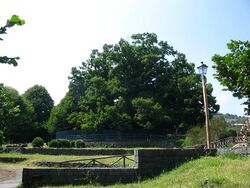Biology:Hundred Horse Chestnut



[ ⚑ ] 37°45′00.7″N 15°7′49.4″E / 37.750194°N 15.130389°E
The Hundred-Horse Chestnut (Italian: Castagno dei Cento Cavalli; Sicilian: Castagnu dî Centu Cavaddi) is the largest and oldest known chestnut tree in the world.[1][2] Located on Linguaglossa road in Sant'Alfio, on the eastern slope of Mount Etna in Sicily[3] — only 8 km (5.0 mi) from the volcano's crater — it is generally believed to be 2,000 to 4,000 years old (4,000 according to botanist Bruno Peyronel from Turin).[4] It is a sweet chestnut (Castanea sativa, family Fagaceae). Guinness World Records has listed it for the record of "Greatest Tree Girth Ever", noting that it had a circumference of 57.9 m (190 ft) when it was measured in 1780. Above ground, the tree has since split into multiple large trunks, but below ground, these trunks still share the same roots. An early 1895 image with a man next to the tree for perspective, shows it was closer to 10 m in diameter at breast height, rather than the claimed 18.5 m in diameter at breast height. [5]
Despite its name, the tree is not a horse chestnut. Rather, the tree's name originated from a legend in which a queen of Aragon and her company of 100 knights, during a trip to Mount Etna, were caught in a severe thunderstorm. The entire company is said to have taken shelter under the tree.[3][6]
History
The tree is located in the wood of Carpineto, on the eastern slope of the Etna volcano, near zone D of the Etna park.
Authors of botany agree the chestnut tree is thousands of years old but do not agree on its exact age.[clarification needed] It is likely between two and four thousand years old. The thesis of the Turin botanist Bruno Peyronel suggests it could be 3-4 thousand years old, making it the oldest tree in Europe and the largest in Italy (1982).[7][8]
The first historical information on the Chestnut of the Hundred Horses is documented as early as the sixteenth century. In 1611 Antonio Filoteo[9] spoke of it, while in 1636, in "Il Mongibello", Pietro Carrera majestically described the trunk and the tree "... capable of accommodating thirty horses inside".[10]
On 21 August 1745, a first act was issued by the "Court of the Order of the Royal Heritage of Sicily",[11] with which the Chestnut of the Hundred Horses and the nearby Chestnut Nave were institutionally protected. This document is configured, by virtue of the historical period (late eighteenth century), among the first acts - if not the first ever - of environmental protection produced in Sicily.[12]
Literary allusions
The tree and its legend have become the subject of various songs and poems, including the following Sicilian-language description by Catanese poet Giuseppe Borrello (1820–1894):
Un pedi di castagna |
A chestnut tree |
Another poet from Catania in Sicily, Giuseppe Villaroel (1889–1965), described the tree in the following sonnet (written in Italian):
Dal tronco, enorme torre millenaria, |
From the trunk, huge millenary tower, |
The 2018 novel The Overstory by American writer Richard Powers includes the line that: "Seven hundred years before, a chestnut in Sicily two hundred feet around sheltered a Spanish queen and her hundred mounted knights from a raging storm."
See also
References
- ↑
 This article incorporates text from a publication now in the public domain: Chisholm, Hugh, ed (1911). "Chestnut". Encyclopædia Britannica. 6 (11th ed.). Cambridge University Press. pp. 112–113.
This article incorporates text from a publication now in the public domain: Chisholm, Hugh, ed (1911). "Chestnut". Encyclopædia Britannica. 6 (11th ed.). Cambridge University Press. pp. 112–113.
- ↑ "Chestnut Dinner in the Mountains of Italy". Barilla online. 2005. Archived from the original on 2006-10-18. https://web.archive.org/web/20061018214824/http://www.barillaus.com/Chestnut_Dinner__Intro.aspx. Retrieved 2006-12-22.
- ↑ 3.0 3.1 Senna, Luciana (2005). Authentic Sicily. Touring Editore. p. 112. ISBN 88-365-3403-1. https://books.google.com/books?id=ISBN8836534031..
- ↑ Lewington, Anna; Edward Parker (2002). Ancient Trees: Trees That Live for 1,000 Years. Sterling Publishing Co.. p. 92. ISBN 1-85585-974-2. https://books.google.com/books?id=ISBN1855859742.
- ↑ "Sweet Chestnut 'Castagno dei 100 cavalli' at Castagno dei Cento Cavalli, Sant'Alfio, Sicily, Italy". https://www.monumentaltrees.com/en/ita/sicily/santalfio/2310_castagnodeicentocavalli/3519/.
- ↑ The Chestnut tree of Mount Etna, detailed account of the tree, its state and its surroundings, written by Wm. Rushton on June 29, 1871.
- ↑ "Copia archiviata". http://www.comune.sant-alfio.ct.it/castagnostoria.htm.
- ↑ Enciclopedia italiana e dizionario della conversazione: opera originale. 1842. pp. 1009–. https://books.google.com/books?id=dWZBAAAAcAAJ&pg=PA1009. Retrieved 23 January 2011.
- ↑ Giuseppe M di Ferro e Ferro (1830). Biografia degli Uomini Illustri Trapanesi. pp. 1–. https://books.google.com/books?id=KECgazsNvRgC&pg=RA1-PA178. Retrieved 23 January 2011.
- ↑ Pietro Carrera (1636). Il Mongibello descritto da Pietro Carrera in tre libri: nel quale oltra diuerse notitie si spiega l'historia degl'incendi, e le cagioni di quelli. https://books.google.com/books?id=GrI-QgAACAAJ. Retrieved 23 January 2011.
- ↑ Giovanni E. di Blasi e Gambacorta (1846). Storia del regno di Sicilia dell'epoca oscura e favolosa sino al 1774: seguita da un'appendice sino alla fine del secolo XVIII. pp. 688–. https://books.google.com/books?id=kuc_AAAAcAAJ&pg=PA688. Retrieved 23 January 2011.
- ↑ "www.salvalartesicilia.it". http://www.salvalartesicilia.it/focus/?argomento=monumenti&page=doc008.htm.
- ↑ 13.0 13.1 "Poesie sul Castagno dei Cento Cavalli". (Sicilian) Catania Natura. Dipartimento di Botanica, University of Catania. http://www.dipbot.unict.it/ctnatura/flora/LIR_100.html. Retrieved 2006-12-22.
External links
- "Various illustrations of the tree throughout history". Archived from the original on May 9, 2006. https://web.archive.org/web/20060509023642/http://www.comune.sant-alfio.ct.it/stampe.htm. Retrieved December 22, 2006.
 |

